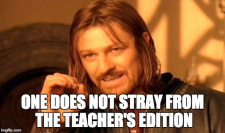Creating Time for Your Inner-Genius


I had a major problem in my last year as a first grade teacher. I had been teaching for several years and the students were so far ahead with two months to go that I had to figure out what to do with them. The year before, I decided to give them a head start on second grade curriculum thinking they would lose some during the summer break. I discovered that this was a major no-no and akin to taking a teacher’s personal parking space. Following a pretty good tongue-lashing by the second grade teachers, I was entering April with a choice, do I do it again? Or do I figure out something else to do for our final 2 months together?
One thing that always bothered me as a teacher was the curriculum. The school I was teaching at and the team I was teaching with would rarely stray from it. The Teacher’s Edition was like a Holy Bible for a newer teacher as it provided the scope, sequence and pacing of delivery of content. There was one MAJOR problem with this….it didn’t take into account the kids. I was forcing them to learn math through fake story problems involving trains moving in opposite directions and learn history of whatever the textbook or standard dictated and never any more than that.

So with almost all the first grade content covered and a couple months of school left, I decided to consult the most important people in the school about what to do with the time….the students. I asked them what they wanted to learn about for the remainder of our time together. I had hoped for maybe one or two ideas but instead I got 22 different ideas for 22 different kids. It makes sense when you think about it. They each are unique and have different passions, so why wouldn’t they come up with things they are interested in? The choices ranged from tornadoes to the actress Rachel Weisz (yes, a little boy named Sean was obsessed with her).
After gathering their list of ideas I presented them with a challenge – tie in all the core areas of curriculum – writing, science, reading, math and social studies into their passion and present a final project the represents all of these areas. While the school day was still fairly structured with centers and finishing up the final pieces of first grade curriculum, I started giving them an hour or more each day to work on their “passion project”.
I didn’t know it at the time, but this is exactly the way companies like Google work with their 20% time. It’s also the basis behind the concept of “Genius hour” in schools. Spend the majority of your time working on the “work” but then carve out pockets of time to explore your passions and inner genius. I’ve also heard it referred to as “Interest-based Learning.” Whatever you want to call it, I stumbled into it my last year of teaching and immediately had regret. Not regret for doing it, but regret for not doing it sooner.

The content of our COWs – Apple’s iBook
The classroom bubbled with energy whenever the students had time to work on their projects. With only 4 computers in the room (do you remember Compaq computers?), they had limited research time and time to create. I ended up locating the one COW (Computers on Wheels) at the time which was full of a dozen pearl-white Apple iBooks (image left). I told the rest of the school that I would be the computer “farmer” in charge of the COW until the end of the year as my kids were using it heavily to wrap up their projects.
Tools and ideas to transform education. Sign up below.
The amount of creativity energy flowing out of room 52 that year was breath-taking. During the last week of school, each of the students presented their passion project. I invited their parents in to see the final outcomes. Mary’s project on horses involved a history of horse migration to North America, an original poem on horses, and even math story problems on horses (“If two horses leave a barn at the same time heading in opposite directions…”). Every student rose to the challenge and while it was hard for some to tie in the core content areas (Rachel Weisz was particularly challenging), they each accomplished the goals on the rubric.
So how do we make the time in schools for students to follow their inner-genius or passion? Some schools create Genius Hour time one day a week or one class period a week. Others, like one of our elementary campuses, creates something called “Enrichment Clusters” (based on the work of Joseph Renzulli) where not only do the students get to explore their passions, but the teachers get to teach their passions as well. Courses range from coding to yoga to golf in these clusters where students learn and ultimately present their project at the end of a 9-week time period.
As the students in my class wrapped up their projects that year, I felt extremely rewarded for making the choice I had for our time together those final weeks.They had the time to explore their inner-genius and had rewarded me by showing their learning. Thusly, I wanted to reward them for taking on this idea with such fervor. I tried to find some sort of trinket or object for each of them associated with their project. The boy who’s passion was Harry Potter got a stuff-three headed dog named Fluffy. The girl who was passionate about surfing got a charm bracelet full of different surf boards.
Oh, and in case you are wondering what happened with the student who created the Rachel Weisz project, I decided to reach out to the actress’ handlers but didn’t get a response. I ended up asking Sean to present on the last day just in case she decided to send a note or something. On the last day of school, his reward arrived:

It’s amazing what students can accomplish if you give them some voice and some choice. As a teacher, we need to figure out how to make this time for our students. We all have an inner-genius, we just need the time to explore it.
cross posted at http://hookedoninnovation.com
Carl Hooker has been a part of a strong educational shift with technology integration since becoming an educator. As Director of Innovation & Digital Learning at Eanes ISD, he has helped spearhead the LEAP program, which put one-to-one iPads in the hands of all K-12 students in his 8000-student district. He is also the founder of “iPadpalooza”- a three-day “learning festival” held in Austin annually. He's also the author of the six-book series titled Mobile Learning Mindset, a guide for teachers, administrators, parents and others to support and embrace mobile learning in our schools. Read more at Hooked on Innovation.
Carl Hooker has spent the past 20+ years in education as a teacher and administrator focused on the thoughtful integration of technology and innovation. He consults for multiple districts across the country and is a frequent speaker at state and national events. In his free time he's an author, DJ, podcast host, Poetry Slammer, and Trivia Night MC. He's the co-founder of the social platform K12Leaders.com. Check out his latest book Ready Set FAIL! Now available for order here: https://mrhook.it/fail Read more of his blogs at Hooked on Innovation.
